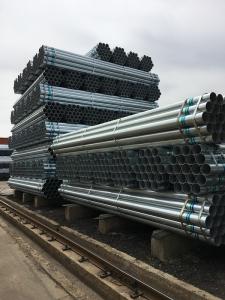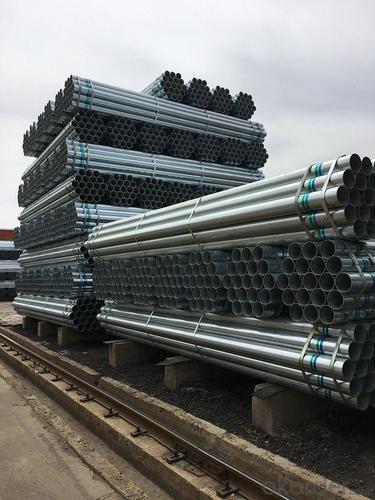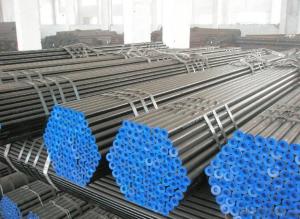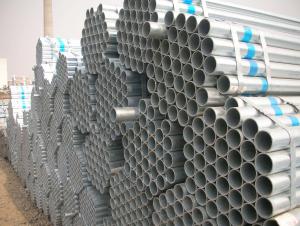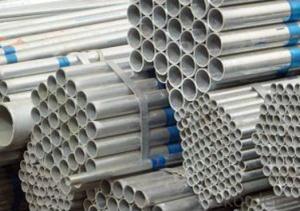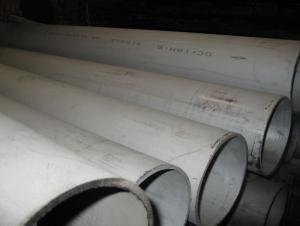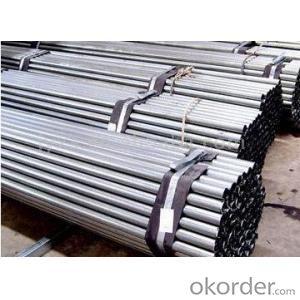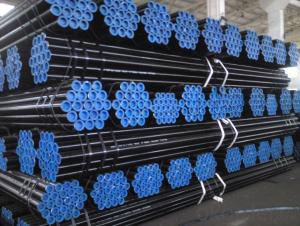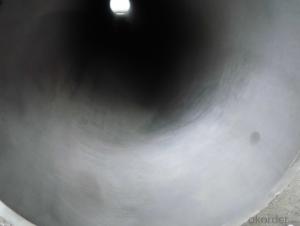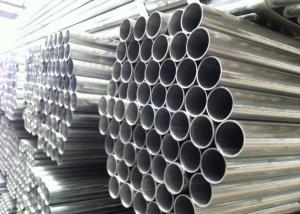Pregalvanized galvanized seamless steel pipe price
- Loading Port:
- Tianjin
- Payment Terms:
- TT or LC
- Min Order Qty:
- 25 m.t.
- Supply Capability:
- 50000 m.t./month
OKorder Service Pledge
OKorder Financial Service
You Might Also Like
1、Structure of Pregalvanized galvanized seamless steel pipe price:
a. Galvanized steel pipe is a kind of hot-rolled or cold-rolled galvanized steel for the blankafter the cold bending forming hollow section steel sectional shapes made by high-frequency welding.
b. For petroleum/ natural gas pipeline, for conveying water, drainage, coal gas, mineral slurry and other low-middle pressure liquids. Also for chemical industry, building structure, heat-supply, pile driving projects and greenhouse construction.
c. Galvanized steel is widely used in construction, machinery, coal, chemical,railway vehicles, the automotive industry, roads, bridges, container, sports and facilities,agricultural machinery, petroleum machinery, mining machinery and equipment and other manufacturing industries.
2、Main Features of Pregalvanized galvanized seamless steel pipe price:
• High manufacturing accuracy
• High strength
• Small inertia resistance
• Strong heat dissipation ability
• Good visual effect
• Reasonable price
3、Pregalvanized galvanized seamless steel pipe price Specification:
Standard | GB, DIN, ASTM ASTM A106-2006, ASTM A53-2007 |
Grade | 10#-45#, 16Mn 10#, 20#, 45#, 16Mn |
Thickness | 8 - 33 mm |
Section Shape | Round |
Outer Diameter | 133 - 219 mm |
Place of Origin | Shandong, China (Mainland) |
Secondary Or Not | Non-secondary |
Application | Hydraulic Pipe |
Technique | Cold Drawn |
Certification | API |
Surface Treatment | factory state or painted black |
Special Pipe | API Pipe |
Alloy Or Not | Non-alloy |
Length | 5-12M |
Outer Diameter | 21.3-610mm |
Grade | 20#, 45#, Q345, API J55, API K55, API L80, API N80, API P110, A53B |
Standard | ASME, ASTM |
1) Material:20#(ASTM A 106/A53 GRB.API5LGRB,GB),45#,16Mn,10#.
2) Specification range:OD:21.3-610mm,WT:6-70mm,length:6-12m or according to the requirement of clients.
3) Excutive standards:GB,ASME API5L.ASTM A 106/A53,Despite of the above standards,we can also supply seamless steel pipe with standard of DIN,JIS,and so on,and also develop new products according to the requirements of our clients!
4) Surface:black lacquered,varnish coating or galvanized.
5) Ends:Beveled or square cut,plastic capped,painted.
6) Packing:bundles wrapped with strong steel strip,seaworthy packing.
4、Packaging & Delivery
Packaging Details: | seaworthy package,bundles wrapped with strong steel strip |
Delivery Detail: | 15-30days after received 30%TT |
5、FAQ of Pregalvanized galvanized seamless steel pipe price:
①How is the quality of your products?
Our products are manufactured strictly according to national and internaional standard, and we take a test
on every pipe before delivered out. If you want see our quality certifications and all kinds of testing report, please just ask us for it.
Guaranteed: If products’ quality don’t accord to discription as we give or the promise before you place order, we promise 100% refund.
②How about price?
Yes, we are factory and be able to give you lowest price below market one, and we have a policy that “ for saving time and absolutely honest business attitude, we quote as lowest as possible for any customer, and discount can be given according to quantity”,if you like bargain and factory price is not low enough as you think, just don’t waste your time.Please trust the quotation we would give you, it is professional one.
③Why should you chose us?
Chose happens because of quality, then price, We can give you both.Additionally, we can also offer professional products inquiry, products knowledge train(for agents), smooth goods delivery, exellent customer solution proposals.Our service formula: good quality+good price+good service=customer’s trust
SGS test is available, customer inspection before shipping is welcome, third party inspection is no problem.
6、Pregalvanized galvanized seamless steel pipe price Images:
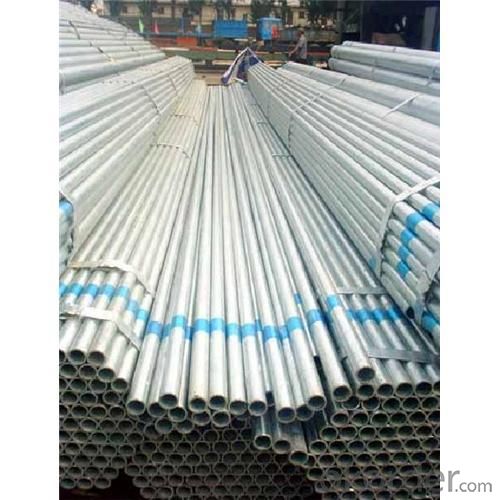
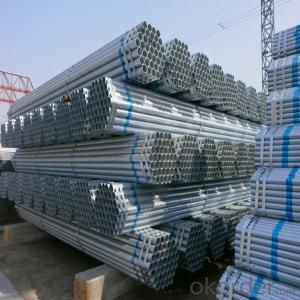
- Q: Can steel pipes be used for underground irrigation systems?
- Certainly, underground irrigation systems can indeed utilize steel pipes. Steel pipes have gained popularity for irrigation systems owing to their exceptional durability, strength, and corrosion resistance. They have the capability to endure the immense pressure and stress associated with being buried underground, thus ensuring longevity without the need for frequent maintenance or replacement. Moreover, the smooth interior surface of steel pipes enables efficient water flow and minimizes the risk of clogging. Additionally, steel pipes are readily available in a variety of sizes and can be easily customized to meet specific requirements of irrigation systems. However, it is crucial to ensure that the steel pipes employed for underground irrigation systems are adequately coated or treated to prevent corrosion and extend their lifespan.
- Q: How are steel pipes classified based on their schedule?
- Steel pipes are classified based on their schedule, which refers to the thickness of the pipe walls. The schedule classification system includes different numerical values, such as Schedule 10, Schedule 40, and Schedule 80, to categorize pipes with varying wall thicknesses.
- Q: How are steel pipes used in the power generation sector?
- Steel pipes are widely used in the power generation sector for various purposes. They are primarily used for transporting fluids, such as water, steam, and oil, as well as gases, in power plants. Steel pipes are also used for constructing pipelines that carry fuel, like natural gas or coal, to power plants. Additionally, they are used for structural purposes, supporting equipment, and maintaining the overall integrity of power generation facilities.
- Q: Are steel pipes suitable for underground gas distribution?
- Steel pipes are indeed appropriate for the distribution of gas underground. Due to their remarkable strength, durability, and resistance to corrosion, steel pipes are extensively employed in gas distribution systems. The ability of steel pipes to endure the pressure and stress in underground environments renders them a dependable choice for gas transportation. Moreover, steel pipes possess the added benefit of being capable of withstanding high temperatures and resisting fire, making them a secure alternative for underground gas distribution. Nonetheless, it is crucial to ensure that the steel pipes employed are adequately coated and shielded against corrosion to guarantee their longevity and avert any possible leaks or harm.
- Q: How do you calculate the pipe pressure drop coefficient for steel pipes?
- To calculate the pipe pressure drop coefficient for steel pipes, you can use the Darcy-Weisbach equation. This equation relates the pressure drop in a pipe to various factors such as the flow rate, pipe diameter, pipe length, and the properties of the fluid being transported. The pressure drop coefficient, also known as the friction factor or the Darcy-Weisbach friction factor, is denoted by the symbol f. It is a dimensionless parameter that represents the resistance to flow in the pipe. The value of f depends on the flow regime, which can be laminar or turbulent. For laminar flow, which occurs at low flow rates or with viscous fluids, the pressure drop coefficient can be calculated using the Hagen-Poiseuille equation. This equation relates the pressure drop to the fluid viscosity, pipe length, pipe diameter, and flow rate. However, for turbulent flow, which occurs at higher flow rates, the calculation of the pressure drop coefficient is more complex. It depends on the roughness of the pipe wall, which affects the flow resistance. The roughness is typically quantified using the relative roughness, which is the ratio of the pipe wall roughness to the pipe diameter. To calculate the pressure drop coefficient for turbulent flow in steel pipes, you can use empirical correlations or Moody's diagram. Moody's diagram provides a graphical representation of the friction factor as a function of the Reynolds number and the relative roughness. The Reynolds number represents the flow regime and is calculated using the fluid properties, flow rate, and pipe dimensions. By finding the intersection of the Reynolds number and relative roughness on Moody's diagram, you can determine the corresponding pressure drop coefficient. It's important to note that the pressure drop coefficient for steel pipes may vary depending on the specific pipe dimensions, surface roughness, and fluid properties. Therefore, it is recommended to consult relevant standards or engineering references for accurate and up-to-date values of the pressure drop coefficient for steel pipes in your specific application.
- Q: What are the different types of steel pipe fittings for plumbing systems?
- Some common types of steel pipe fittings used in plumbing systems include elbows, tees, unions, couplings, reducers, and caps. Elbows are used to change the direction of the pipe, while tees allow for branching off into multiple directions. Unions are used to join two pipes together, couplings are used to connect two pipes of the same diameter, and reducers are used to connect pipes of different diameters. Caps are used to seal the end of a pipe.
- Q: Are steel pipes suitable for underground installations?
- Indeed, steel pipes prove to be a fitting option for underground installations. Their durability, strength, and resistance to corrosion have made them a widely utilized choice for such applications. Able to endure high pressure and extreme temperature fluctuations, steel pipes are well-suited for transporting a variety of substances underground, including water, gas, and oil. Moreover, their exceptional resistance to environmental elements such as moisture and chemicals, commonly encountered in underground environments, further enhances their suitability. By implementing appropriate coatings and cathodic protection systems, steel pipes can enjoy an extended lifespan and retain their integrity even under harsh underground conditions. Consequently, steel pipes emerge as a dependable and fitting selection for underground installations.
- Q: How does galvanization protect steel pipes from corrosion?
- Galvanization protects steel pipes from corrosion by creating a protective zinc layer on the surface of the steel. This zinc layer acts as a barrier, preventing moisture and oxygen from reaching the steel, thus inhibiting the formation of rust and corrosion.
- Q: How are steel pipes protected against ultraviolet radiation?
- Steel pipes are typically protected against ultraviolet radiation by applying a layer of protective coating or paint. This coating acts as a barrier, preventing the harmful effects of UV rays from deteriorating the steel and reducing its lifespan.
- Q: What are the environmental impacts of steel pipe manufacturing?
- The environmental impacts of steel pipe manufacturing include the extraction and processing of raw materials, such as iron ore and coal, which can lead to deforestation and habitat destruction. Manufacturing processes, such as smelting and rolling, release significant amounts of greenhouse gases and pollutants into the atmosphere, contributing to climate change and air pollution. Additionally, the disposal of waste materials, such as slag and other byproducts, can contaminate soil and water sources. However, advancements in technology and the adoption of sustainable practices can help mitigate these impacts.
Send your message to us
Pregalvanized galvanized seamless steel pipe price
- Loading Port:
- Tianjin
- Payment Terms:
- TT or LC
- Min Order Qty:
- 25 m.t.
- Supply Capability:
- 50000 m.t./month
OKorder Service Pledge
OKorder Financial Service
Similar products
Hot products
Hot Searches
Related keywords
